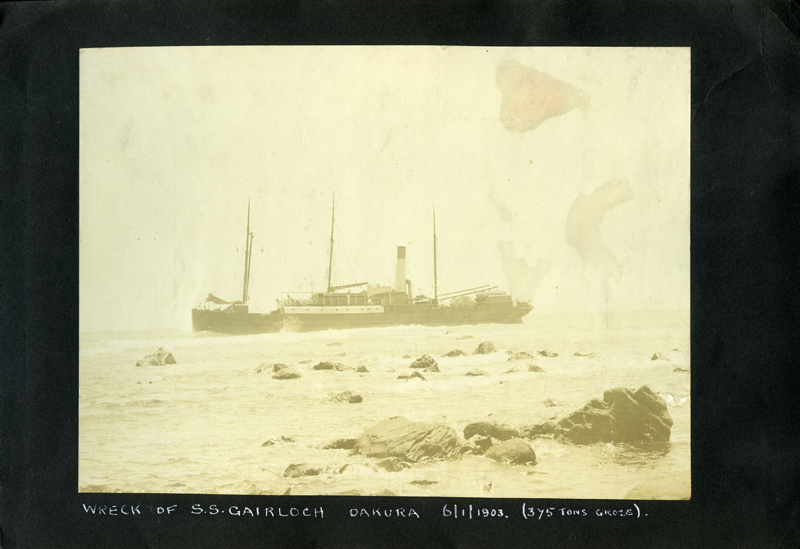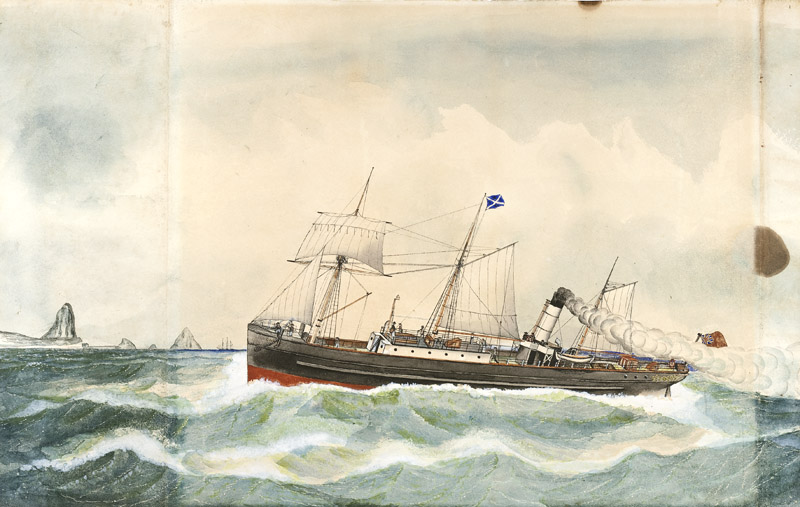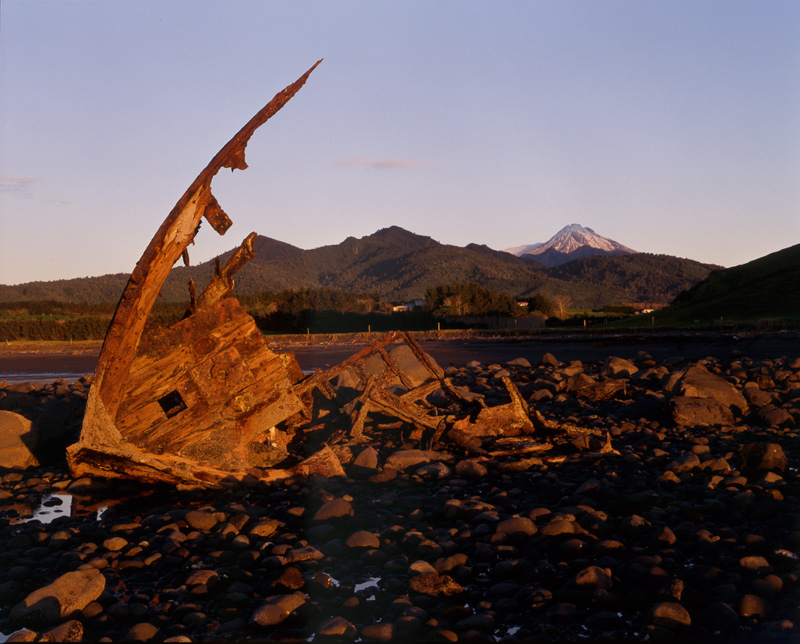



The rusted crescent of iron rising from the rocky foreshore at Weld Rd has been a Taranaki landmark for 100 years. Once part of the starboard bow of the SS Gairloch, it has been the focus of many a sunset photograph, a relic that has awed generations. A short wade out to sea, the bottom plates, remnants of the ship's engines and boiler lie collapsed upon themselves, home to kina and the occasional crayfish.
It is a landmark that has gradually diminished over the century that has passed since the once proud coastal steamer slid on to the rocks at 11.40pm on the dark, moonless night of 5 January 1903. Storm, time, tide and the occasional souvenir hunter have almost imperceptibly eroded the ship's 345 tons. Only a close observer would have noticed that the rib that was in place last year now lies shattered among the rocks, the last fragments of wooden deck are now reduced almost to splinters.
On passage from Onehunga to Wanganui with stops at Raglan, Kāwhia and Opunake, the Gairloch had narrowly missed collision with her sister ship, the Ngāpuhi, off New Plymouth just an hour before she ran on to the Timaru Reef. Despite ‘thick’ weather, there was only a slight swell and a light wind and the ship seemed to slide over the rocks before grinding to a standstill.
Captain Austen and the second mate were on the bridge at the time of the stranding, which occurred at high tide. Rockets were fired, attracting the attention of local residents, Messrs Corkill, Staite and Mills, who stood by on the beach, unable to see the activity at sea as the crew escaped unharmed from the stranding. In the early light of day the Gairloch could be seen high and dry.
A contemporary account reads: ‘Rowing the ship's boats to the New Plymouth breakwater, the crew were met by Mr Knowles the proprietor of the Breakwater Hotel who administered to their needs’. The harbour board’s dredge, Thomas King, returned Captain Austen and his officers to the wreck where they salvaged the crew's personal effects, the ship's silverware, linen, upholstery and spirits. Captain Hood, the harbourmaster, assessed the wreck, which was extensively holed, as unsalvageable.
The Gairloch has held a lifetime connection for New Plymouth resident Dorice Cowling-Holmes. Her father, Frederick Cowling, was only a young farmhand of 17 when the ship came ashore. "He was living on the Timaru Road and working for the Honeyfields then," she said. "The shipwreck was a really big event. It was a huge occurrence in his life, there was not a lot else happening down on the Timaru Road."
The days after the stranding saw the Gairloch battered by stormy seas, which left her deck cargo of timber strewn over local beaches. Most of the Gairloch's general cargo, which included a large amount of sugar and flour, cement, drain pipes and two carriages, was successfully salvaged. Horses and drays were backed out into the sea alongside the wreck and the cargo and usable equipment brought ashore.
When the official salvage was over, the wreck was sold to Mr A. Bayly for £20 and the residual cargo to Mr H. Mills for five shillings. Despite the interference of souvenir seekers and vandals, they managed to salvage most of the ship's machinery. History fails to record whether the ship's whistle was a souvenir or legitimate salvage, but legend has it that for years it served as the knock-off hooter at Henry Brown Ltd's sawmill at Inglewood.
By mid-April 1903 the ship was starting to break up and was left to the elements and the attention of the locals. On his day off young Fred Cowling was allowed to take a bullock cart down to the wreck to see if he could find himself something useful. Neither the cast iron bollard, nor the porthole that he unbolted were really of much use in his whare on the farm, but both souvenirs went with him when he left, and on his later moves. The captain's bridge chair and the brass bulkhead lamp had more practical applications, while the brass ring from the captain's cabin door, set in a stone taken from the beach, has served as a convenient doorstop for 100 years.
The stranding and Fred's part in the salvage never lost its magic. The annual pilgrimage to the Gairloch became a family tradition that continued throughout his lifetime and has been carried on by Dorice and her family. "It is a tradition we have kept going. If it is too wet we might go a day or two later, but we have always gone."
There is an interesting side effect from their annual picnic: An 80-year legacy of photographs chronicles the gradual deterioration of the Gairloch. In 2003, when the ship celebrated its century ashore, Dorice, now 82 and almost blind, marked the occasion with another pilgrimage to the jaw-like wreck. Before the event, she said: "I'll be a starter even if I am led there on a leash."
Built in Glasgow by Messrs Blackwood and Gordon in 1884 especially for the Waitara trade, the Gairloch was a steel, twin-screw three-masted steamer of 373 tons. After being lengthened by 17ft 6ins (5.2m) in 1886 she became 164ft overall with a beam of 23ft and drew 8.7ft. She was powered by two 85hp engines and had a maximum speed of 11 knots.
The Gairloch had salon accommodation for 20 passengers and a ladies' cabin for 10 that could be doubled if pressed. She was capable of carrying 100 bullocks or 340 tons of cargo. Her first contact with the Taranaki coast was a stranding on the Waitara River bar in 1887. She subsequently grounded in that river on four other occasions.
In the Manukau Harbour she was involved in a collision with another ship and in a separate incident lost one propeller when she struck a rock after her rudder chains jammed. Jammed rudder chains were also responsible for the Gairloch beaching at the Wanganui River mouth in 1890. The Gairloch was valued at £12,000 and, along with the other ships of the Northern Steamship Company, was uninsured.
As a result of the stranding, Captain Austen appeared at a marine inquiry in Auckland before Mr Haselden SM, assisted by Captains Clarke and Fernandez as assessors. The court found that Captain Austen had committed an error of judgment in hugging the land so closely on a dark night and suspended his certificate for three months. He was ordered to pay £10 towards the cost of the inquiry.
Puke Ariki Heritage Collection: Oil painting of the SS "Gairloch" run aground.
LinkPuke Ariki Heritage Collection: A round wooden box with " WOOD FROM / " GAIRLOCH " SAVED BY / FREDERICK JOHN COWLING / 1903 " engraved on a metal plaque.
LinkPuke Ariki Heritage Collection: A small set of bronze and copper balance scales from the Gairloch.
LinkPuke Ariki Heritage Collection: Early undated photograph entitled "New Plymouth Cargo and Cattle Wharves, with the S.S. 'Wakatipu' and 'Gairloch' alongside, from the end of the Breakwater."
LinkPlease do not reproduce these images without permission from Puke Ariki.
Contact us for more information or you can order images online here.